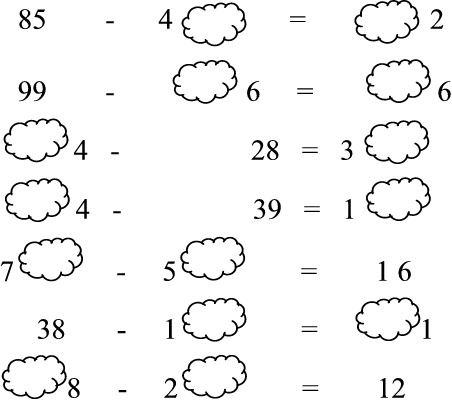| << Chapter < Page | Chapter >> Page > |
1. 4
2.1 2 4
2.2 3 3
2.3 6 6
2.4 5 5
2.5 1 5
2.6 7 2
2.7 3 6
Difference
Addition
Only 2 factors have/can only be divided by 1 and itself.
Always divisible by 2.
1. 13 – 7 5. 91 - 3
2. 31 – 3 6. 97 - 7
3. 53 – 5 7. 59 – 7
4. 71 – 11
1. How accurately can you still subtract? The grid contains a hidden number. Use the clues to colour in the blocks that will reveal the number.
1.1 14 – 9
1.2 17 – 8
1.3 21 – 7
1.4 23 – 6
1.5 20 – 12
1.6 42 – 13
1.7 45 – 18
1.8 39 – 16
1.9 34 – 15
1.10 104 – 7
1.11 106 – 8
1.12 103 – 8
1.13 101 – 5
| 2 | 12 | 106 | 8 | 18 | 19 |
| 81 | 66 | 70 | 21 | 5 | 63 |
| 101 | 12 | 50 | 14 | 117 | 80 |
| 64 | 73 | 9 | 109 | 68 | 76 |
| 7 | 98 | 86 | 29 | 22 | 72 |
| 27 | 96 | 38 | 17 | 8 | 97 |
| 88 | 71 | 11 | 95 | 83 | 3 |
2. More fun!
You must now think carefully. Do you still remember what the “inverse” of subtraction is? This may help us find the answer to subtraction sums quickly. Work with a partner and see who is the first one to identify the figure that is hidden behind each cloud!

The answer to a subtraction sum is called the .
The inverse of subtraction is
Learning Outcome 1: The learner will be able to recognise, describe and represent numbers and their relationships, and to count, estimate, calculate and check with competence and confidence in solving problems.
Assessment Standard 1.9: We know this when the learner performs mental calculations involving:
1.9.1: addition and subtraction.

Notification Switch
Would you like to follow the 'Mathematics grade 6' conversation and receive update notifications?